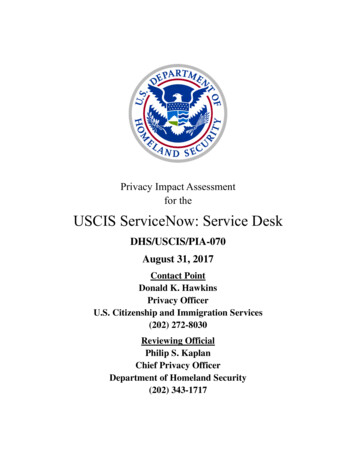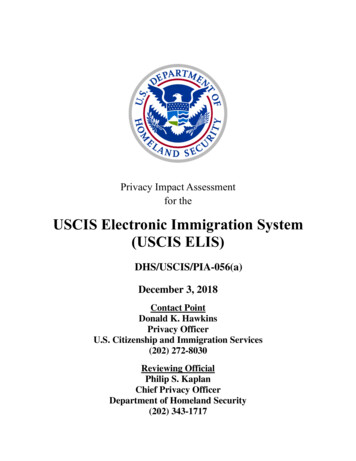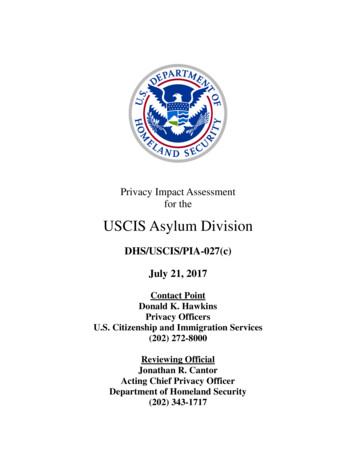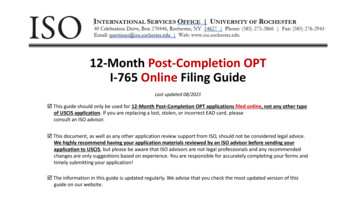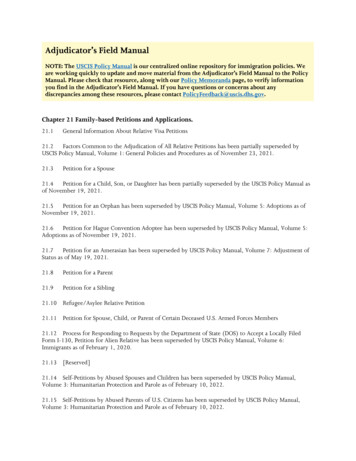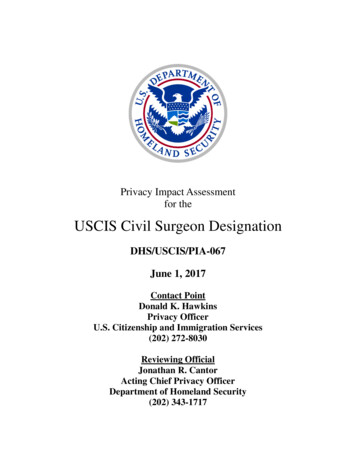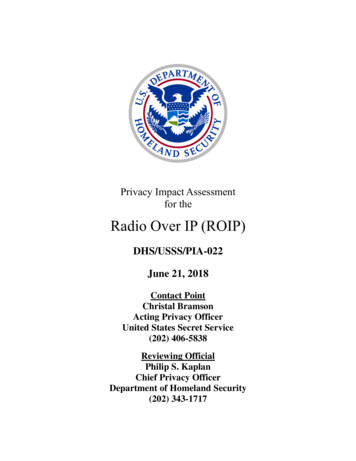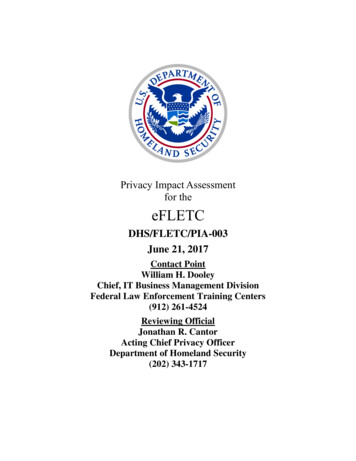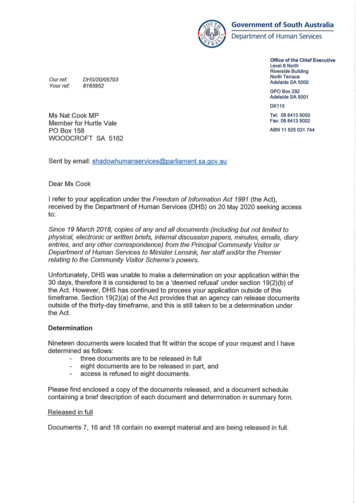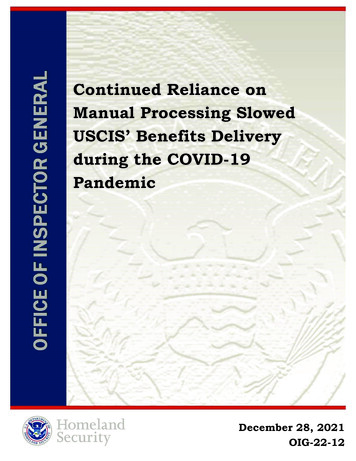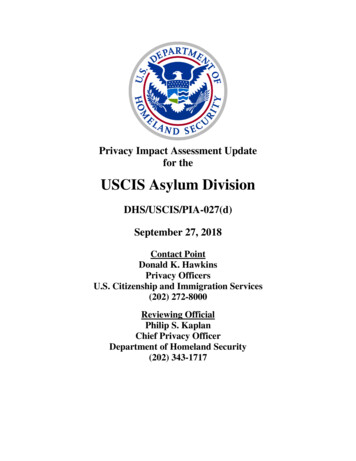
Transcription
Privacy Impact Assessment Updatefor theUSCIS Asylum DivisionDHS/USCIS/PIA-027(d)September 27, 2018Contact PointDonald K. HawkinsPrivacy OfficersU.S. Citizenship and Immigration Services(202) 272-8000Reviewing OfficialPhilip S. KaplanChief Privacy OfficerDepartment of Homeland Security(202) 343-1717
Privacy Impact Assessment UpdateDHS/USCIS/PIA-027(d) USCIS Asylum DivisionPage 1AbstractThe Asylum Division of the U.S. Citizenship and Immigration Services (USCIS)adjudicates applications for asylum, benefits pursuant to Section 203 of the NicaraguanAdjustment and Central American Relief Act (NACARA § 203), withholding of removal underthe terms of a settlement agreement reached in a class action,1 and screening determinations forsafe third country, credible fear, and reasonable fear. The Asylum Division historically used theRefugees, Asylum, and Parole System (RAPS) and the Asylum Pre-Screening System (APSS) insupport of its mission critical functions. Both systems were originally developed by the formerImmigration and Naturalization Service (INS). The Asylum Division is seeking to retire APSS andRAPS and use Global, operating in a cloud-based environment, to serve as the primary IT casemanagement system for the administration of affirmative asylum, NACARA § 203, withholdingof removal under the terms of a settlement agreement reached in a class action, credible fear, andreasonable cases. USCIS is updating this Privacy Impact Assessment (PIA) because the AsylumDivision uses the new cloud-based Global system and has migrated records, containing personallyidentifiable information (PII), from APSS and RAPS into Global in order to conduct itsadjudications.OverviewUSCIS oversees lawful immigration to the United States. As set forth in Section 451(b) ofthe Homeland Security Act of 2002, Public Law 107-296, Congress charged USCIS withadministering the asylum program. USCIS, through its Asylum Division, administers theaffirmative asylum program to provide protection to qualified individuals in the United States whohave suffered past persecution or have a well-founded fear of future persecution in their countryof origin, as outlined under Section 208 of the Immigration and Nationality Act (INA), 8 U.S.C. §1158 and 8 CFR Part 208. The USCIS Asylum Division also adjudicates the benefit programestablished by the Nicaraguan Adjustment and Central American Relief Act (NACARA) § 2032and administers safe third country, credible fear, and reasonable fear screening processes.3The Asylum Division supports the following four programs:1. AsylumEvery year people come to the United States seeking protection because they have sufferedpersecution or fear that they will suffer persecution on account of race, religion, nationality,membership in a particular social group, or political opinion. The two ways to obtain asylum in1American Baptist Churches v. Thornburgh, 760 F. Supp. 796 (N.D. Cal. 1991) (ABC Settlement).Pub. L. No. 105-100, 111 Stat. 2193 (1997), amended by Pub. L. No. 105-139, 111 Stat. 2644 (December 2, 1997).3Section 203 of Pub. L. No. 105-100.2
Privacy Impact Assessment UpdateDHS/USCIS/PIA-027(d) USCIS Asylum DivisionPage 2the United States are through the affirmative process before USCIS, and the defensive processbefore an immigration judge in the Executive Office for Immigration Review in the Departmentof Justice (EOIR). To obtain asylum, the individual must be physically present in the United States.Generally, an individual may apply for affirmative asylum status regardless of how he or shearrived in the United States or his or her current immigration status. An individual may include hisor her spouse and/or unmarried children present in the United States as derivatives on his or herasylum application. A defensive application for asylum occurs when an individual requests asylumas a defense against removal from the United States. In defensive asylum cases, the individual iscurrently in removal proceedings in immigration court with EOIR.USCIS is responsible for the administration and adjudication of the affirmative asylumprocess. Individuals granted asylum status possess this status indefinitely, may work in the UnitedStates, may request derivative status for immediate family members within two years of the grantof asylum status, and may apply for permanent residence after one year.2. Nicaraguan Adjustment and Central American Relief Act (NACARA Section 203)Section 203 of NACARA applies to certain individuals from Guatemala, El Salvador, andthe former Soviet bloc countries (the Soviet Union or any republic of the former Soviet Union,such as Russia, Latvia, Lithuania, Estonia, Albania, Bulgaria, the former Czechoslovakia, theformer East Germany, Hungary, Poland, Romania, or Yugoslavia or any state of the formerYugoslavia) who entered the United States and applied for asylum by specified dates or registeredfor benefits. Section 203 of NACARA allows qualified individuals to apply for suspension ofdeportation or for special rule cancellation of removal under the standards similar to those in effectbefore the Illegal Immigration Reform and Immigrant Responsibility Act of 1996. If granted,individuals receive lawful permanent resident status.3. Credible Fear ScreeningsSection 235 of Immigration and Nationality Act (INA), as amended, and its implementingregulations provide that certain categories of individuals are subject to expedited removal withouta hearing before an immigration judge. These include: arriving stowaways; certain arriving aliensat ports of entry who are inadmissible under section 212(a)(6)(C) of the INA (because they havepresented fraudulent documents or made a false claim to USCIS or other materialmisrepresentations to gain admission or other immigration benefits) or 212(a)(7) of the INA(because they lack proper documents to gain admission); and certain designated aliens who havenot been admitted or paroled into the United States.Individuals subject to expedited removal who indicate an intention to apply for asylum,express a fear of persecution or torture, or a fear of return to their home country are referred toUSCIS asylum officers to determine whether they have a credible fear of persecution or torture.Individuals determined to have a positive credible fear of persecution or torture are placed into
Privacy Impact Assessment UpdateDHS/USCIS/PIA-027(d) USCIS Asylum DivisionPage 3removal proceedings under INA § 240 by the issuance of a Notice to Appear, and may apply forasylum, withholding of removal or deferral of removal under the INA or the Convention AgainstTorture as a defense to removal before an immigration judge.4. Reasonable Fear ScreeningsSections 238(b) and 241(a)(5) of the INA provide for streamlined removal procedures thatprohibit certain individuals (i.e., those subject to a final administrative removal order foraggravated felons under section 238(b) or subject to reinstatement of a prior order of exclusion,deportation, or removal under section 241(a)(5) of the INA) from contesting removability beforean immigration judge and from seeking any relief from removal. If an individual ordered removedunder either section 238(b) or section 241(a)(5) of the INA expresses a fear of return to the countryto which he or she has been ordered removed, the case must be referred to a USCIS asylum officer,who determines whether the individual has a reasonable fear of persecution or torture. Individualsfound to have a reasonable fear of persecution or torture may seek withholding or deferral ofremoval before an immigration judge.Reason for the PIA UpdateUSCIS Asylum Division primarily relied on legacy Refugees, Asylum, and Parole System(RAPS) and the Asylum Pre-Screening System (APSS) Mainframe to facilitate the adjudicationand administration of affirmative asylum, NACARA § 203, credible fear, and reasonable fearcases. The RAPS and APSS Mainframe operating systems have become outdated since they wereoriginally built and have been supplemented by modern technology. USCIS migrated the legacyRAPS and APSS Mainframe operating systems to a cloud-based platform, called Global. Thistechnological advancement does not impact the collection and use of records in Global from theprevious legacy system, but does modify the way USCIS stores and maintains affirmative asylum,NACARA § 203, credible fear, and reasonable fear cases records. All RAPS and APSS recordswere moved into Global.On December 9, 2010, the Office for Management and Budget (OMB) released a “25 PointImplementation Plan to Reform Federal Information Technology Management,” which requiredthe Federal Government to immediately shift to a “Cloud First” policy.4 The three-part OMBstrategy on cloud technology revolves around using commercial cloud technologies when feasible,launching private government clouds, and utilizing regional clouds with state and localgovernments when appropriate.425 Point Implementation Plan to Reform Federal Information Technology Management (December 9, 2010),available at oreform-federal-it.pdf.
Privacy Impact Assessment UpdateDHS/USCIS/PIA-027(d) USCIS Asylum DivisionPage 4When evaluating options for new IT deployments, OMB requires that agencies default tocloud-based solutions whenever a secure, reliable, cost-effective cloud option exists. Cloudcomputing is defined by the National Institute of Standards and Technology (NIST) as “a modelfor enabling ubiquitous, convenient, on-demand network access to a shared pool of configurablecomputing resources (e.g., networks, servers, storage, applications, and services) that can berapidly provisioned and released with minimal management effort or service provider interaction.”Cloud computing is defined to have several deployment models, each of which provides distincttrade-offs for agencies that are migrating applications to a cloud environment.USCIS is undergoing a legacy system modernization effort to align with the “Cloud First”policy in order to improve business operations. The USCIS Asylum Division is now primarilyserved by Global, a cloud-based information technology. Global replaced APSS and RAPS as partof an overall Office of Information Technology initiative to move all mainframe applications tomodern cloud-based platforms. As mentioned above, RAPS and APSS were built using a legacyMainframe system. Global operates on the Amazon Web Services (AWS) cloud platform5 andcombines the functionality of both mainframe systems into one application with a commoninterface. This migration does not impact the collection and use of records in Global from theprevious legacy systems. Historical and existing case data from APSS and RAPS was extractedfrom the legacy systems and transferred to Global. USCIS requires AWS to segregate Global datafrom all other data residing in the cloud.Global is a comprehensive case management tool that enables USCIS Asylum to handleand process applications for asylum pursuant to Section 208 of the INA and applications forsuspension of deportation or special rule cancellation of removal pursuant to NACARA § 203. Thesystem also supports USCIS in the screening of individuals in the credible fear and reasonable fearprocesses. Global continues to capture attorney information, such as name, firm, and address. Eachattorney is linked to a system-generated identification code.AWS is a public cloud designed to meet a wide range of security and privacy requirements(e.g., administrative, operational and technical controls) that are used by USCIS to protect data inaccordance with federal security guidelines.6 AWS is Federal Risk and Authorization ManagementProgram (FedRAMP)-approved and authorized to host PII. FedRAMP is a U.S. Government-wideprogram that delivers a standard approach to the security assessment, authorization, andcontinuous monitoring for cloud t/aws-us-eastwest?status Compliant&sort productName.Public clouds are owned and operated by third-party service providers whereas private clouds are those that arebuilt exclusively for an individual enterprise.6
Privacy Impact Assessment UpdateDHS/USCIS/PIA-027(d) USCIS Asylum DivisionPage 5Privacy Impact AnalysisAuthorities and Other RequirementsThe authority to collect information by the Asylum Division is set forth in the Immigrationand Nationality Act, 8 U.S.C. §§ 1103, 1158, 1225, 1228, and Title II of Public Law 105-100 andin the implementing regulations found in title 8 of the Code of Federal Regulations (CFR). As setforth in Section 451(b) of the Homeland Security Act of 2002, Public Law 107-296, Congresscharged USCIS with the administration of the asylum program, which provides protection toqualified individuals in the United States who have suffered past persecution or have a wellfounded fear of future persecution in their country of origin as outlined under INA § 208 and 8CFR § 208. USCIS is also responsible for the adjudication of the benefit program established byNACARA § 203, in accordance with 8 CFR §§ 240.60 – 240.70, and the maintenance andadministration of the credible fear and reasonable fear screening processes, in accordance with 8CFR §§ 208.30 and 208.31.The following SORNs cover the collection, maintenance, and use of information by theAsylum Division: The Alien File, Index, and National File Tracking System SORN covers the informationmaintained in the Alien File (A-File),7 including hardcopy records of asylum applications,NACARA § 203 applications, credible fear screenings, reasonable fear screenings, andsupporting documentation;8 The Immigration Biometric and Background Check SORN covers background checks andtheir results;9 and The Asylum Information and Pre-Screening SORN covers the collection, use, andmaintenance of asylum applications, NACARA § 203 applications, credible fearscreenings, and reasonable fear screenings.10Global is covered as a minor system under the Digital Innovation Development –Information Technology (DID-IT) Amazon Web Services (AWS) accreditation boundary. DIDIT completed the security assessment and authorization documentation in August 2013, and wasaccepted into the Ongoing Authorization program. Ongoing Authorization requires DID-IT,including Global, to be reviewed on a monthly basis and sustain its security and privacy posturein order to maintain its Authority to Operate.7USCIS creates an A-File for each individual.DHS/USCIS-001 Alien File, Index, and National File Tracking System of Records, 82 FR 43556 (Sept. 18, 2017).9DHS/USCIS-018 Immigration Biometric and Background Check (IBBC) System of Records, 83 FR 36950 (July31, 2018).10DHS/USCIS-010 Asylum Information and Pre-Screening System of Records, 80 FR 74781 (Nov. 30, 2015).8
Privacy Impact Assessment UpdateDHS/USCIS/PIA-027(d) USCIS Asylum DivisionPage 6Characterization of the InformationThis update does not impact the collection of information in Global. USCIS continues tocollect and maintain the information outlined in Section 2.0 of the DHS/USCIS/PIA-027(c)Asylum Division, published on July 21, 2017. 11 There are no changes to the forms used by theAsylum Division.Uses of the InformationThis update does not impact the use of information in Global. USCIS uses Global tomanage, control, and track the process of affirmative asylum applications, applications forsuspension of deportation or special rule cancellation of removal pursuant to NACARA § 203, aswell as credible fear and reasonable fear screenings. USCIS uses the information in Global to trackcase status, facilitate scheduling appointments, issue notices throughout the process, and generatedecision documents. USCIS also uses these records to initiate, facilitate, and track security andbackground check screenings, and to prevent the approval of any benefit prior to the review andcompletion of all security checks. Finally, USCIS uses these records to generate statistical reportsto assist with oversight of production and processing goals.NoticeThis PIA update provides general notice to the public that USCIS retired APSS and RAPSand is using Global as the primary IT case management system for the administration andadjudication of asylum, NACARA § 203, credible fear, and reasonable fear cases. USCIScontinues to provide notice to individuals through a Privacy Notice in the associated forms and theassociated SORNs.Data Retention by the projectThis update does not impact the retention of information in Global. USCIS stores thephysical documents and supplemental documentation in the A-File and processes asylum requestsin the respective case management system. The A-File [N1-566-08-11] records are permanent,whether hard copy or electronic, until destroyed, according to the National Archives and RecordsAdministration (NARA) schedule N1-566-08-11. USCIS transfers the A-Files to the custody ofNARA 100 years after the individual’s date of birth.NARA approved the retention schedule N1-563-04-06 for RAPS and N1-563-04-07 forAPSS. According to both schedules, Master File automated records are maintained for 25 yearsafter the case is closed, then archived for 75 years, and then destroyed. USCIS is planning toconsolidate the RAPS and APSS Retention Schedule to cover Global and maintain data for 100years and then destroy the information to align with the approved A-File schedule. This retention11See DHS/USCIS/PIA-027(c) Asylum Division, available at www.dhs.gov/privacy.
Privacy Impact Assessment UpdateDHS/USCIS/PIA-027(d) USCIS Asylum DivisionPage 7schedule allows the individual to adjust status and naturalize. It also allows USCIS to promptlyaddress any follow-up inquiries (e.g., requests related to security inquiries and Freedom ofInformation Act/Privacy Act matters).Information SharingThis update does not impact the internal and external sharing in Global. USCIS continuesto collect and maintain the information outlined in Section 2.0 of the DHS/USCIS/PIA-027(c)Asylum Division, published on July 21, 2017.RedressThis update does not impact how access, redress, and correction may be sought throughUSCIS. USCIS continues to provide individuals with access to their information through a PrivacyAct or Freedom of Information Act (FOIA) request. Individuals not covered by the Privacy Act orJudicial Redress Act (JRA) still may obtain access to records consistent with FOIA unlessdisclosure is prohibited by law or if the agency reasonably foresees that disclosure would harm aninterest protected by an exemption. U.S. Citizens and Lawful Permanent Residents may also file aPrivacy Act request to access their information. If an individual would like to file a Privacy Act orFOIA request to view his or her USCIS record, the request can be mailed to the following address:National Records CenterFreedom of Information Act/Privacy Act ProgramP. O. Box 648010Lee’s Summit, MO 64064-8010Persons not covered by the Privacy Act or JRA are not able to amend their records through FOIA.Should a non-U.S. person find inaccurate information in his or her record received through FOIA,he or she may visit a local USCIS Field Office to identify and amend inaccurate records withevidence.Auditing and AccountabilityUSCIS ensures that practices stated in this PIA comply with federal, DHS, and USCISpolicies and procedures, including standard operating procedures, orientation and training, rulesof behavior, and auditing and accountability procedures.USCIS employs technical and security controls to preserve the confidentiality, integrity,and availability of the data, which are validated during the security authorization process. Usersare required to complete an access request form that is approved by a supervisor before they aregranted access. USCIS also implements Role Based Access Controls, which give each user astandard role and a standard set of permissions to prevent the user from accessing anything outsidetheir assigned role. These technical and security controls limit access to USCIS users and mitigatesprivacy risks associated with unauthorized access and disclosure to non-USCIS users.
Privacy Impact Assessment UpdateDHS/USCIS/PIA-027(d) USCIS Asylum DivisionPage 8Further DHS security specifications also require auditing capabilities that log the activityof each user in order to reduce the possibility of misuse and inappropriate dissemination ofinformation. All user actions are tracked via audit logs to identify information by useridentification, network terminal identification, date, time, and data accessed. All USCIS systemsemploy auditing measures and technical safeguards to prevent the misuse of data.In addition, all contracted cloud service providers must also follow DHS privacy andsecurity policy requirements. Before using AWS, USCIS verifies through an independent riskassessment that AWS met all DHS and USCIS privacy and security policy requirements. Further,all cloud-based systems and service providers are added to the USCIS Federal InformationSecurity Modernization Act (FISMA) inventory and are required to undergo a complete securityauthorization review to ensure security and privacy compliance. As part of this process, the DHSSenior Agency Official for Privacy reviews all FedRAMP cloud service providers for privacycompliance and privacy controls assessments as part of the privacy compliance review process.Privacy Risk: There is a risk that Global records can be accessed by unauthorizedpersonnel since Global now resides in AWS, a public cloud.Mitigation: This risk is mitigated. Although Global operates in a public cloud, it isseparated from other public cloud customers. Global operates in a Virtual Private Cloud, which isa private component to the public cloud. USCIS controls access to the systems within the cloud,not AWS.Responsible OfficialDonald K. HawkinsPrivacy OfficerU.S. Citizenship and Immigration ServicesDepartment of Homeland SecurityApproval Signature[Original signed and on file at the DHS Privacy Office]Philip S. KaplanChief Privacy OfficerDepartment of Homeland Security
RAPS and APSS Mainframe operating systems to a cloud-based platform, called Global. This . convenient, on-demand network access to a shared pool of configurable computing resources (e.g., networks, servers, storage, applications, and services) that can be . Program (FedRAMP)-approved and authorized to host PII. FedRAMP is a U.S. Government-wide
